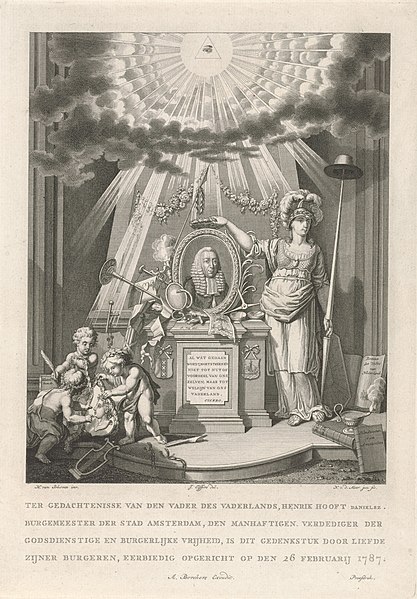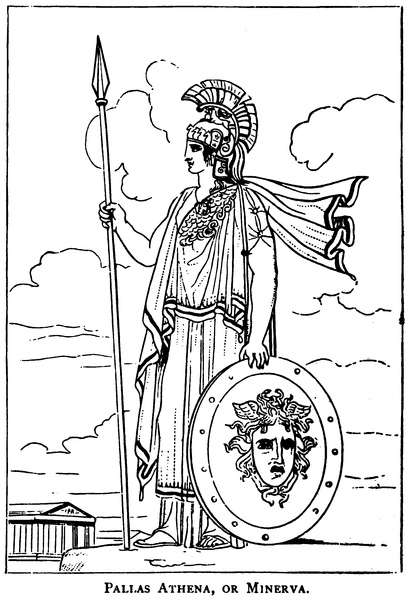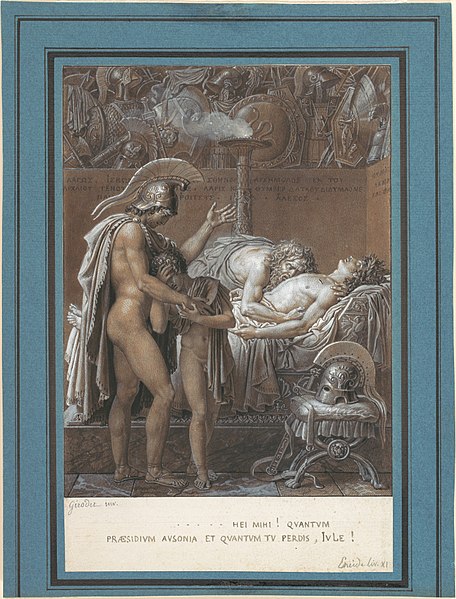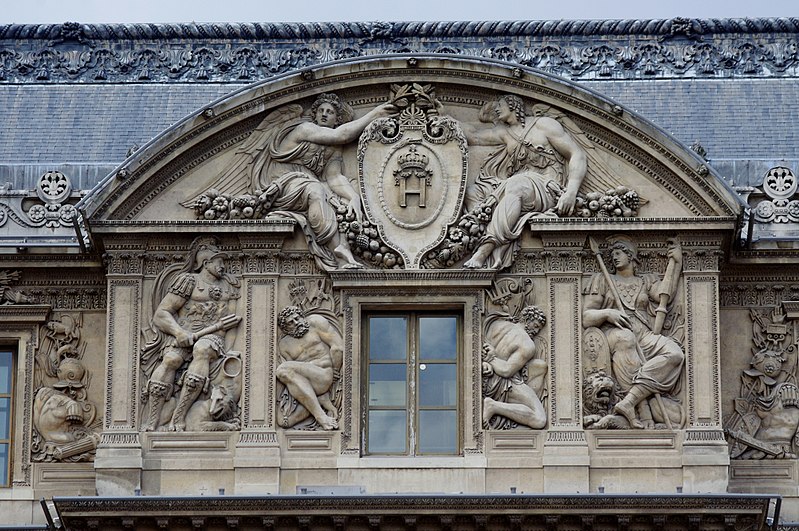Among the primordial Titans, Pallas holds a place, though not as celebrated as Cronus or as notorious as Atlas. As a figure less explored, he invites us into a narrative filled with familial ties, celestial conflicts, and the ancient ethos that shaped the Hellenic mythos.
Pallas Key Facts
| Parents | Crius and Eurybia |
| Partners | Styx |
| Siblings | Astraeus, Perses |
| Offspring | Zelus, Nike, Kratos and Bia |
| Other names | – |
| Roman name | – |
| The God of | Warfare |
| Symbols | Spear |
Name and Etymology
The name Pallas resonates with a martial tone, often associated with warfare and combat prowess. It’s a name shared with other figures within Greek mythology, including Pallas Athena, the virgin goddess of wisdom. The etymological roots of Pallas are believed to be derived from the Greek word ‘pallo’. It ranslates to brandish, reflecting a martial essence.

The absence of a Roman name for Pallas perhaps signifies the Titan’s lesser-known status among the pantheon of ancient deities.
Pallas Origins
The lineage of Pallas is rooted in the early cosmos, born to Crius and Eurybia, figures representing the cosmic forces of constellations and the sea’s might respectively. Among his siblings, Astraeus and Perses shared the ancient world’s stage, each playing their part in the unfolding mythic narrative.
His emergence into the cosmos is a part of the natural progression of the ancient world’s formation, a step towards filling the void with beings of power and purpose.
Pallas, embodying the spirit of warfare, symbolizes an aspect of the ancient Greek understanding of conflict and struggle. His persona is not as elaborately chronicled as other deities. However it reflects the inherent tumult and strife that marked the cosmic narrative, setting the stage for the epic battles that would later define the Greek mythic landscape.
Pallas Lovers and Relationships
The story of Pallas extends into the realm of love and companionship through his union with Styx, the goddess of the river of hatred in the Underworld. This alliance bore fruit, giving birth to potent forces personified as their children.
Relationship with Styx
The union of Pallas and Styx is a narrative of alliance and progeny. Styx, a figure representing the unyielding and harsh realities of the Underworld, found companionship in Pallas, a being embodying martial vigor. Their relationship, though not elaborately romanticized in myths, signifies a union of primal forces.
From their bond emerged offspring embodying various aspects of strength and dominance – Zelus (Zeal), Nike (Victory), Kratos (Strength), and Bia (Force). These children, often seen accompanying Zeus, symbolize the inherent virtues and forces necessary for maintaining cosmic order, a testament to the legacy of Pallas and Styx.
Zelus (Zeal)
Zelus, the personification of zeal and rivalry, embodies an aspect of the competitive spirit inherent in the ancient Greek ethos.
Nike (Victory)
Nike, perhaps the most recognized among Pallas’ progeny, symbolizes victory. Her iconic wings and association with triumph in battle echo the martial essence of her father, Pallas.
Kratos (Strength) and Bia (Force)
Kratos and Bia, representing strength and force respectively, are the epitome of raw power and the unyielding force of will. Their existence is a reflection of their fathers’ association with battle and warfare.
Depiction And Characteristics
The imagery surrounding Pallas often resonates with the essence of a warrior. His association with the spear, a symbol of combat and warfare, paints a picture of a figure ready for battle. The sparse artistic representations often depict him in a stance of readiness. Moreover embodying the eternal vigilance and combat readiness that marked the ancient Greek understanding of warfare.

The symbols associated with Pallas, though few, are potent representations of his martial essence. The spear, a timeless symbol of combat, is often seen as an extension of Pallas. It was a tool through which the Titan exercised his dominion in the realm of conflict.
Pallas Personality
The personality of Pallas, as gleaned from the sparse stories, reflects a being of action. Furthermore embodying the ancient Greek virtues of courage, strength, and martial skill. His actions resonate with a sense of duty and the unyielding spirit of a warrior.
The perception of him by the ancient Greeks, though not as elaborately documented as other deities, likely carried a tone of respect and awe, a recognition of the Titan’s place within the cosmic hierarchy and the martial spirit he embodied.
Pallas Roles And Responsibilities
His existence, a representation of the ancient world’s tumult, showcases the inherent struggle for dominance that marked the early cosmic narrative.
The responsibilities of Pallas, though not extensively chronicled, likely revolved around the realm of conflict. This was a domain where his martial prowess and strategic mind found expression. His place within the cosmic hierarchy, fits with the inherent struggle that drives the narrative of existence forward.
Myths about Pallas
One of the notable mentions of him is within the narrative of the Gigantomachy, the epic battle between the gods and the Gigantes, where his encounter with Athena unfolds into a tale of combat and strategy.

Pallas and the Gigantomachy
The Gigantomachy, often intertwined with the War of the Titans, showcases a realm of celestial conflict where the immortal Titans and their mortal brethren, the Gigantes, clashed with the Olympian gods. The narrative, as explored in various ancient texts, unfolds a tale of struggle, triumph, and the eternal quest for cosmic dominance.
In the midst of this celestial conflict, the encounter between Pallas and Athena unfolds into a narrative of martial prowess and strategic mastery. As recounted in Pseudo-Apollodorus’ Bibliotheca, written in the 2nd century AD, Athena, the virgin goddess of wisdom and warfare, engages in combat with Pallas, a testament to the martial essence embodied by the Titan.
“[In the War of the Gigantes :] She [Athena] stripped the skin off Pallas and used it to protect her own body during the battle.” – Pseudo-Apollodorus, Bibliotheca 1. 38 (trans. Aldrich)
This encounter ends with Athena’s victory. She not only defeats Pallas but also flays him, using his skin as a shield.
Pallas In Ancient Greek Religion
The story of Pallas doesn’t find any real expression within the religious practices of ancient Greece.
The absence of elaborate worship practices or dedicated temples to Pallas showcases the Titan’s lesser-known status.
Representations Of Pallas In Art
The representation of Pallas in ancient Greek art is not as extensive, as other deities. The sparse depictions available often resonate with the martial essence of the Titan, showcasing a being of strength and combat readiness.

The imagery surrounding Pallas, though limited, offers a glimpse into the ancient Greek understanding of warfare and conflict. This was a realm where beings like Pallas stood as symbols of the martial spirit.
Mentions in Ancient Texts
The narrative of Pallas, though not as extensively explored as other deities, finds mentions in a few ancient texts. These mentions, though sparse, offer a glimpse into the ancient Greek understanding of him and his martial essence.
Hesiod’s Theogony
Hesiod, a Greek poet traditionally regarded as a contemporary of Homer, provides a genealogical account of the Greek gods in this work. In Theogony, he is mentioned as the son of Crius and Eurybia, and the father of Zelus, Nike, Kratos, and Bia by Styx. This narrative lays the foundation for understanding the lineage and progeny of Pallas within the broader Greek mythic landscape.
“And Styx the daughter of Ocean was joined to Pallas and bore Zelus (Emulation) and trim-ankled Nike (Victory) in the house. Also she brought forth Cratos (Strength) and Bia (Force), wonderful children.” – Hesiod’s Theogony (lines 383-385)
Apollodorus’ Bibliotheca
Another mention of Pallas comes from Apollodorus’ Bibliotheca. It is a comprehensive work on Greek mythology written around the 1st or 2nd century BC. Apollodorus, an Athenian grammarian and scholar, provides a detailed account of the Greek gods and heroes in this work. In Bibliotheca, Pallas’ relationship with Styx and the birth of their offspring is repeated, supporting the narrative provided by Hesiod.
Hyginus’ Fabulae
Pallas also finds mention in Hyginus’ Fabulae. A collection of myths and legends compiled by Gaius Julius Hyginus, a Latin author from the 1st century BC. Though not as detailed as other sources, Fabulae provides a brief mention of Pallas. He is reiterating his lineage and progeny, and contributing to the sparse yet intriguing narrative surrounding the Titan.
Frequently Asked Questions
Known for his martial essence and association with warfare, Pallas stands as a Titan, a precursor to the Olympian gods. He embodies the ancient Greek understanding of conflict and struggle. Moreover, his legacy transitions smoothly into the realm of the Olympian gods, showcasing a continuous narrative of martial valor from ancient to classical Greek mythology.
Pallas, through his union with Styx, fathered four significant deities: Zelus (Zeal), Nike (Victory), Kratos (Strength), and Bia (Force). These offspring embody various aspects of strength and dominance, reflecting the martial lineage of their father.
The primary symbol associated with him is the spear, a timeless emblem of warfare and combat. This symbol reflects Pallas’ martial essence and his dominion within the realm of conflict.
One of the notable mentions of Pallas is within the narrative of the Gigantomachy. This was the epic battle between the Olympian gods and the Giants.
Featured Image Credit: Constantin Hansen, Public domain, via Wikimedia Commons
